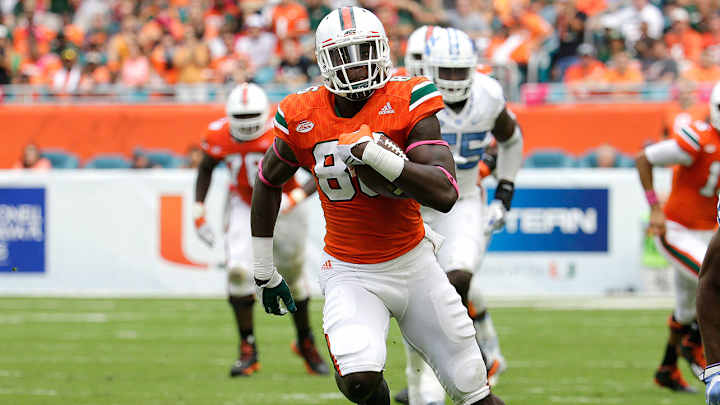2017 NFL draft prospect countdown, No. 29: David Njoku, TE, Miami

After redshirting for his first season in Miami, 2014, Njoku averaged 17.2 yards per reception during the 2015 campaign—highest among all ACC tight ends with at least 20 catches. He posted a 16.2 yards-per-catch clip last season, while reeling in 43 grabs and scoring eight times. Seven of those eight scores came over the back half of Miami’s season, including one in the Russell Athletic Bowl vs. West Virginia.
In high school, the Cedar Grove, N.J., native was a national champion in the high jump, taking the title at the 2014 New Balance Nationals Outdoors with a mark of 2.11 meters. He was recruited as a wide receiver, then bulked up and moved to tight end during his redshirt year.
Strengths: Ever wondered what it would look like if Cam Newton played tight end? Well ...
According to MockDraftable.com, which tracks players’ measurements and testing numbers, one of the closest skill-position comparisons to Njoku from a physical perspective is Newton, a 2011 draft pick. Njoku (6' 4", 246 lbs.) ran a 4.64-second 40 at the combine, with a 37" vertical, 133" broad jump and a 6.97-second three-cone time. The Miami product is a freak.
Former USC stars Jackson, Smith-Schuster enjoying pre-draft process
“I think wherever I go, I can definitely bring speed,” Njoku said. “I’m willing to block anywhere, attached or detached. Speed. And a lot of fun.”
Njoku shifted from an inline role to the slot for Miami. He also can (and did) split out wide, further complicating alignment headaches for opposing defenses. No matter where he starts out a play, he’s a threat to get downfield—he has the speed simply to run past linebackers or even safeties, along with the size to go up over the top for contested catches.
At times, though, he really does profile more like a slot receiver than a tight end. That is particularly true when he has the ball in his hands. Miami utilized him on bubble screens from the slot, and he had an eye-popping TD vs. Pittsburgh in which he slipped off a block to the flat, outran the safety’s angle and then leaped over a DB into the end zone. Even if his route-running takes time to develop, his next team should be able to pick up chunks of yardage by dialing up those quick passes.
Weaknesses: He tried hard as a blocker, which is the nice way of saying that he’s not a very good blocker. Njoku is more of an in-the-way presence than anyone Miami could trust to make real headway. Not that tight ends should be left alone with edge rushers that much anyway, but the Hurricanes usually had to make sure they had help for Njoku in those situations. He could create an initial stalemate as a run blocker, but that was about all—any counter move or extra push from the man he was blocking made things difficult for Njoku.
There is room to develop there, for sure—remember, he weighed 220 and played a different position as of 2014. But he’ll have to be paired with a blocking TE early on, if he’s going to play.
As a receiving threat he will have to a) limit his drops (eight of them last season), and b) become more nuanced in his routes. Sprinting through the second and third levels won’t work as well at the NFL level as it did for him in college. Again, there is a nice starting point in this regard, as Njoku has shown that he can plant and break off a route, but he is going to need time.
NFL player comparison: Antonio Gates

Chris Burke covers the NFL for Sports Illustrated and is SI.com’s lead NFL draft expert. He joined SI in 2011 and lives in Ann Arbor, Mich.